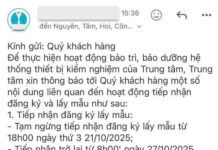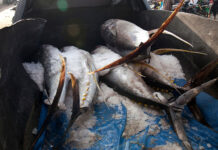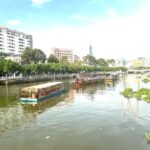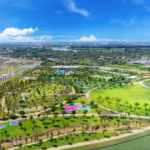The Ho Chi Minh City Department of Transportation has submitted a report to the city’s People’s Committee regarding the investment in and construction of a temporary water terminal adjacent to the Ba Son station of Metro Line 1.
Previously, Thuong Nhat Company proposed to voluntarily bear the cost of constructing two adjacent water terminals to Ba Son and Tan Cang stations, designed as a bridge-lead floating structure. The addition of these two temporary terminals aims to facilitate passenger connections between the river bus and Metro Line 1, which officially commenced commercial operations on December 22.
The location has been studied by Thuong Nhat Company, and the feasibility of opening a water terminal is confirmed. The company currently operates a river bus service from Bach Dang station (in District 1) to Linh Dong (in Thu Duc City). The inclusion of a water terminal will enhance the diversity of public transport services, maximizing the convenience for passengers accessing Metro Line 1.

Passengers aboard River Bus No. 1
Relevant units, such as the Department of Planning and Architecture, the Urban Railway One-Member Limited Company, and the People’s Committee of District 1, have assessed the proposal and deemed the opening of a water terminal to connect passengers to Metro Line 1 as necessary and in line with the approved 1/2000 subdivision planning for the existing central area (930 hectares).
Therefore, the Ho Chi Minh City Department of Transportation proposes that the People’s Committee approve the policy to allow Thuong Nhat Company to temporarily invest in and construct a water terminal adjacent to the Ba Son station, funded by the company. In terms of scale, the terminal will feature a bridge-lead floating structure without any permanent constructions. The temporary operation will continue until the city requests its clearance and relocation.
The Department also proposes that the People’s Committee instruct the Department of Natural Resources and Environment to guide the company in completing the necessary procedures for renting the water surface and signing a contract for the exploitation of the inland water terminal.
Thuong Nhat Company will be responsible for fulfilling its financial obligations in accordance with the regulations when using the water area for the terminal’s operation and dismantling and relocating the terminal’s components upon the city’s request for clearance and relocation.
The Ultimate Guide to Seamless Transportation: “A Visionary Company’s Plan for Building Two Piers to Connect Bus and Metro Passengers”
The development of the new wharf will enhance and diversify public passenger transport services, catering to the diverse needs of commuters accessing the Metro Line 1.
“Aspiring for a Brighter Future: Ho Chi Minh City Aims for a Per Capita Income of $8,500 by 2025”
Ho Chi Minh City aims to achieve a double-digit growth rate in its regional gross domestic product (RGDP), targeting a rate of over 10% by 2025. This ambitious goal is complemented by an aim to raise the city’s per capita RGDP to approximately 8,500 USD in the same year, a figure that underscores the city’s commitment to economic development and prosperity.
“An Ambitious Target: Ho Chi Minh City Aims High with 53.5 Million Visitors by 2025”
The city’s tourism industry aims to attract 8.5 million international arrivals and 45 million domestic visitors, with a projected total revenue of VND 260 trillion.












































